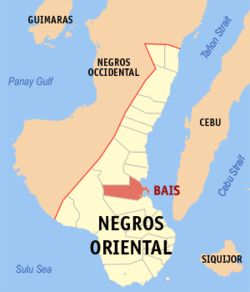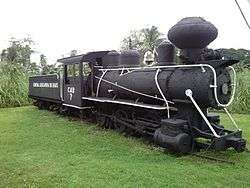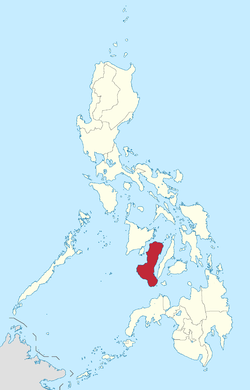Bais, Negros Oriental
| Bais | ||
|---|---|---|
| Component City | ||
| City of Bais | ||
|
Old locomotive in Bais City | ||
| ||
| Nickname(s): Sugar Estate of the South | ||
 Map of Negros Oriental showing the location of Bais | ||
.svg.png) Bais Location within the Philippines | ||
| Coordinates: 09°35′N 123°07′E / 9.583°N 123.117°ECoordinates: 09°35′N 123°07′E / 9.583°N 123.117°E | ||
| Country | Philippines | |
| Region | Negros Island Region (NIR/Region XVIII) | |
| Province | Negros Oriental | |
| District | 2nd district of Negros Oriental | |
| Cityhood | September 7, 1968 | |
| Barangays | 35 | |
| Government[1] | ||
| • Mayor | Mercedes Teves Goñi | |
| • Vice Mayor | Miguel Real | |
| Area[2] | ||
| • Total | 319.64 km2 (123.41 sq mi) | |
| Population (2010)[3] | ||
| • Total | 74,722 | |
| • Density | 230/km2 (610/sq mi) | |
| Time zone | PST (UTC+8) | |
| ZIP code | 6206 | |
| Area code | 35 | |
| Income class | 3rd class | |
Bais, officially City of Bais, is a third class city in the province of Negros Oriental, Philippines. According to the 2015 census, it had a population of 76,291 people.[4] Located 45 kilometres (28 mi) from the provincial capital Dumaguete, it has a land area of 31,964 hectares (78,980 acres).[2]
Geography
There are two bays in the area, hence the name "Bais". The shore line is mostly mangroves, which are in danger of destruction due to the increasing population. The richness of marine life in the bays is because of these mangroves.
Bais City's bays are widely known to have one of the most beautiful coral reefs in the area.
The Pelarta River runs beside the city center. There is, however, a dispute that the name Bais was taken after the eels locally called "Bais" that used to thrive in this river. The river has been the source of irrigation water for the nearby sugar farms. This has been vital in the success of sugar plantations in this area. This river also has a big influence on the city's geography, as it deposits sediments in the former mangrove areas during the (formerly annual) flood season. These former mangrove swamps have now dried out and become populated with residents. In the late seventies, under the government of Genaro Goñi, there was established a river control system stretching from the city center towards the low-lying areas in order to lessen flooding during the rainy season.
Barangays
Bais City is politically subdivided into 35 barangays.[2]
- Barangay I (Pob.)
- Barangay II (Pob.)
- Basak
- Biñohon
- Cabanlutan
- Calasga-an
- Cambagahan
- Cambaguio
- Cambanjao
- Cambuilao
- Canlargo
- Capiñahan
- Consolacion
- Dansulan
- Hangyad
- La Paz
- Lo-oc
- Lonoy
- Mabunao
- Manlipac
- Mansangaban
- Okiot
- Olympia
- Panala-an
- Panam-angan
- Rosario
- Sab-ahan
- San Isidro
- Katacgahan (Tacgahan)
- Tagpo
- Talungon
- Tamisu
- Tamogong
- Tangculogan
- Valencia
History
Etymology
In the early days of Spanish exploration, some Spaniards came upon a swampy land and docked their boats at the vicinity of the two small islets that guarded the village while exploring the place they saw natives fishing along the coast. The Spaniards approached the natives and asked for the name of the place. The natives could not understand Spanish,and believing that the Spaniards were asking for the name of their catch, the natives answered saying "Ba-is", from the day on this swampy valley of the Old Panlabangan and Talamban Hills became known as Bais.[5]
Pioneer in the Sugar Industry
Negros Oriental's economy was far from progressive and its rich soil was not utilized to its full capacity. That was in the 1850s. During those years, people in Negros depict a life of content for they tend to produce goods enough only to meet their daily needs. Even before the sugar boom of the 1850s, Negros Oriental was already producing sugar. The transport of most of its product was mainly done in the ports of Iloilo, which will explain the fast moving pace of development of the sugar industry in Negros Occidental, primarily due to its proximity to Iloilo. This situation was a disadvantage on the movement of sugar from the Oriental plantations.
A wide array of difficulties barred the development of the sugar industry in the Oriental part of the island. The pioneer sugar traders and adventurers include José Rodrigo Camilo Rubio, Diego García-Baena & Agustín de Sandes (from Mexico), Aniceto Villanueva (from Spain), and Vicente-Anunciación Te (later on adapted the surname Teves, from Amoy Province, China). After hearing about the fertility of the flatlands of Bais, these individuals, carved the virgin forests of the eastern side of the island. Many came and settled in the area and planted sugarcane, thus producing muscovado sugar (invented by Vicente-Anunciación Teves) from their mills which was them exported to Spain via Iloilo, the principal shipping point in the Visayas. This was loaded in large sailboats called lurchas or Batel built by Aniceto Villanueva and Joaquín Montenegro (Bais Historian Penn T.Villanueva Larena CPS, MPA).
Bais City credits much of its progress to the Central Azucarera de Bais, the largest producer of raw sugar in Negros Oriental. Established by the Real Compañía-General de Tabacos de Filipinas, S.A. of Spain in the early 1900s, it is also the pioneer in the sugar industry in the Philippines. This industry reached its peak in the 1930s bringing affluence to the Negrenses and enabling them to build stately homes and to acquire properties all over the province.
Driving through the city's main national highway, sugar plantations can immediately be seen on both sides of the road. These areas are characterized by expansive lowlands that stretch as far as the eyes can see and are ideal for sugar planting because of the city's naturally fertile soil. It is no wonder why 73% of the city's total land area is devoted primarily to agriculture.
The Central Azucarera itself is an old foreboding structure of metal and hard wood. The offices may have seen better days, the dank smell of nostalgia hang heavy in the air, but are still functional. Nearby is the Casa Grande, an equally old residential compound surrounded by tall acacia trees, which was built for the use of the employees of the Azucarera. The two storey wooden houses are greatly influenced by old Spanish design and architecture. Much of the houses have undergone restoration and continue to be used as homes of the representatives of the executives of the new management.
Further on are the stately plantation houses owned by sugar planters, mostly standing on one of the lots in the family hacienda. Inside the haciendas are chapels whose altar and icons date back to 1917. Educational visits to these places may be arranged at the Bais City Tourism Office. What is most interesting is you get to tour via the old railroad trams used by the milling companies to hasten sugarcane transport (Bais Historian Mr. Penn T. Villanueva Larena,CPS, MPA).
Demographics
| Population census of Bais | ||
|---|---|---|
| Year | Pop. | ±% p.a. |
| 1990 | 59,591 | — |
| 1995 | 63,355 | +1.15% |
| 2000 | 68,115 | +1.57% |
| 2007 | 74,702 | +1.28% |
| 2010 | 74,722 | +0.01% |
| 2015 | 76,291 | +0.40% |
| Source: National Statistics Office[3] | ||
Economy
Bais City is the largest producer of raw sugar in Negros Oriental. There are two sugar mills in the city. The Central Azucarera de Bais was established by Tabacalera of Spain in the early 1900s and is one of the oldest in the country. The other mill, URSUMCO (Universal Robina Sugar Milling Corporation) was formerly UPSUMCO (United Planters Milling Corporation) and constructed in the mid '70s by Marubeni Corporation of Japan as a project of Ignacio Montenegro (also of Spanish roots). An ethanol plant of the Universal Robina Corporation (URC) that produces bioethanol for the local market has recently been inaugurated.[6]
Education
Bais City has its separated its DepEd Division (Department of Education) from the provincial division. Most of its 35 barangays have their respective public elementary schools and only few have public secondary schools. In the City proper it has elementary and secondary public schools, a college and a state university.
Colleges & universities
- Negros Oriental State University Campus 1 - Sitio San Jose, Barangay II, Bais City
- Negros Oriental State University Campus 2 - Quezon Avenue, National Highway, Bais City
- La Consolacion College - E.C. Villanueva St., Barangay II, Bais City
Elementary & secondary schools
|
|
Culture
An annual fiesta is held each year on September 10 in honor of the city's patron saint San Nicolás de Tolentino, a celebration inherited from the Spanish era. On this occasion, most of the residents prepare food for anyone who visits the place. It is a tradition practiced not only in Bais but in most towns and cities in the Philippines. Lately the celebration has included mardigras and parades.
Bais City is located on the east coast of Negros island, about 45 kilometers north of Dumaguete City, the capital city of Negros Oriental. Its name is derived from the Visayan word "ba-is" for brackish-water eel – a fish species native to the city and one which has become the city's delicacy. A former barrio and later a municipality, Bais officially became a City on 9 September 1968 (R.A. No. 5444).
The territorial jurisdiction of Bais includes two islets (Olympia and Dewey) and the Bais Bay. The Bais Bay area holds a diversity of animal life and is a rich breeding and fishing ground for demersal and other fish species, and also invertebrates. South Bais Bay is also famous for dolphin watching.
Seventy-three percent of the city's total land area is devoted to agriculture, therefore the local economy is dominated by agricultural activities and output. The existing urban area in the city covers only 109.12 hectares. Sugar is the major commercial crop in the city. About thirty-six percent of the city's agricultural land is planted to sugarcane, yielding 1.16 million gross kilograms annually for the domestic and foreign markets. Bais City is also home to two sugar centrals (mills).
Fish production is the city's second income earner, with about 428 hectares of the land area devoted to fishpond development and operation, and fish culture. Bangus (milkfish) culture is the dominant activity. In 2000, the bangus yield in the city was at 722 tons. A geothermal plant with a power generating capacity of 112.3 MW is located at the Municipality of Valencia, Negros Oriental. This plant supplies power to the two Negros provinces, the Panay island, and part of Cebu province.
The Bais City government operates the eco-tourism activities in the city, highlighted by whale and dolphin watching and nature treks. Two annual Bais City festivals have also become tourism events: the Hudyaka sa Bais Mardigras and the Christmas Festival (which showcases giant Christmas decors)since 1950.
A concern of the city is its liquid and solid waste management. At present, liquid wastes are emptied directly without treatment into the Bais basin. The current dumpsite for solid waste is due for closure, and site development for a new 12.5 hectares sanitary landfill is being finalized.
Bais is reported to be the last stronghold of the Spanish language in Philippines. Since some of the Spaniards are in the first settlement area of Negros, (and southeast of Bais) Tanjay.
Notable Baisanons
- Jose Romero, former Philippine Senator; Philippine Ambassador to the Court of St. James; former Secretary of the Department of Education
- Eddie Sinco Romero, National Artist of the Philippines for Cinema and Broadcast Arts.
- Demetrio Larena Sr. - first Governor of Negros Oriental
- Meliton Larena - Board member during the American era
- Vicente G. Sinco - UP President and founder of Foundation University
- Josefa Villanueva Perez - Historian and visual artist
- Francisco Villanueva - Politician & Visual Arts
- Trinidad Teves -Sagarbarria - Founder of Sans Rival Cake house
- Anselma Pinili Teves Villanueva- Founder of la Liga Negrense
- Jean Henri Diago Lhuillier - President & CEO PJ Lhuillier Group of Companies
- Emmylou Villanueva P. Violeta- Art Teacher and Cultural Advocate
- Angela B. Vicente- children advocate and Civic Leader
- Edna Villanueva Diago Lhuillier - Chairman PJ Lhuillier Foundation
References
- ↑ "Cities". Quezon City, Philippines: Department of the Interior and Local Government. Retrieved 13 March 2013.
- 1 2 3 "Province: Negros Oriental". PSGC Interactive. Makati City, Philippines: National Statistical Coordination Board. Retrieved 13 March 2013.
- 1 2 "Total Population by Province, City, Municipality and Barangay: as of May 1, 2010" (PDF). 2010 Census of Population and Housing. National Statistics Office. Retrieved 13 March 2013.
- ↑ "NEGROS ISLAND REGION (NIR)". Census of Population (2015): Total Population by Province, City, Municipality and Barangay (Report). PSA. Retrieved 20 June 2016.
- ↑ Perez Villanueva, Josefa History of Bais 1979 Teves Press
- ↑ URC starts taking fuel ethanol orders
External links
| Wikimedia Commons has media related to Bais, Negros Oriental. |
| Wikivoyage has a travel guide for Bais City. |
- Philippine Standard Geographic Code
- Philippine Census Information
- Local Governance Performance Management System
- List of Philippine Cities
 |
Mabinay / Manjuyod |  | ||
| Bayawan | |
Tañon Strait | ||
| ||||
| | ||||
| Tanjay |



